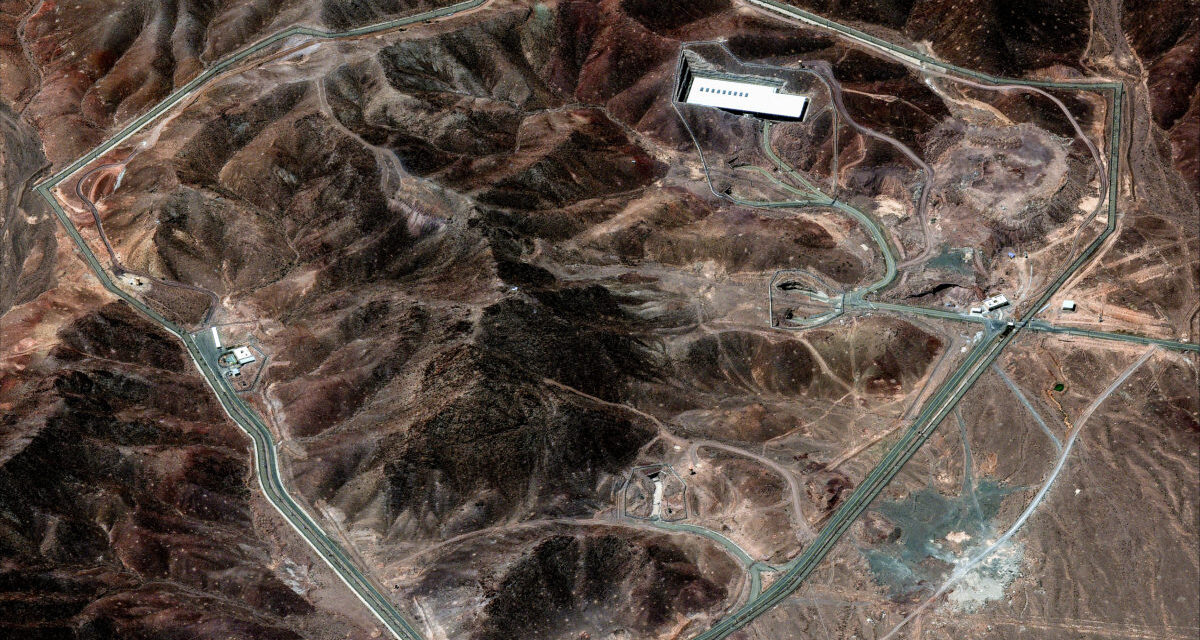A satellite image of the Fordo nuclear facility near Qom, Iran, June 14, 2025 (Maxar Technologies)
Why Iranians Reject Israel’s Alliance with the Shah’s Son
UPDATES: Iran’s Supreme Leader Reappears After Israel’s War
UPDATE, JULY 18:
France, Britain and Germany have warned Iran of renewed UN sanctions if Tehran does not re-enter negotiations over its nuclear program.
Foreign Ministers of the three countries and European Union foreign policy chief Kaja Kallas held their first call with Iran Foreign Minister Abbas Araqchi since Israel’s 12-day war and US strikes on Iranian nuclear sites last month.
“The ministers reiterated their determination to use the so-called ‘snapback’ mechanism in the absence of concrete progress toward such an agreement [on the Iranian nuclear program] by the end of the summer,” said a French official.
A UN Security Council resolution which enshrines the 2015 deal between Iran and the remaining 5+1 Powers (France, Germany, UK, China, and Russia) in the agreement expires on October 18. Sanctions can be re-imposed beforehand under a 30-day process.
UPDATE 1132 GMT:
Seven hundred Iranian activists have signed a statement supporting the call of detained opposition leader Mir Hossein Mousavi for a “fundamental revision of the country’s political structure” and a “free referendum to form a constituent assembly and draft a new constitution based on democracy, national sovereignty, and human rights”.
The signatories said Mousavi’s emphasis on the people’s right to self-determination will save Iran from “repeating deadly historical mistakes”.
All Iranians, regardless of political beliefs, would participate in forming a new government: “Nothing is more necessary and moral than returning power to the people.”
The activists demanded the immediate release of Mousavi and his wife, activist and academic Zahra Rahnavard, from strict house arrest; the unconditional release of all political prisoners; and an end to media censorship.
Mousavi, the leader of Iran’s Green Movement, was the likely first-round leader of the disputed 2009 Presidential election. The regime intervened with the Supreme Leader declaring the re-election of Mahmoud Ahmadinejad, spurring protests by millions of Iranians.
He and Rahnavard were arrested in February 2011.
In a message last week, Mousavi said:
The bitter situation that befell the country was the result of a series of major mistakes….The current structure of the system does not represent all Iranians. People want to see a revision of those errors….
Holding a referendum to establish a constitutional assembly will pave the way for realizing people’s right to self-determination and will discourage enemies of this land from interfering in the country’s affairs.
ORIGINAL ENTRY: A new intelligence assessment raises the prospect that Israel and the Trump Administration will carry out more airstrikes on Iran’s nuclear sites.
“Five current and former US officials” summarized the assessment, which has been shared with lawmakers and officials in allied countries in recent days.
The report found significant damage from US airstrikes, including with “bunker buster” bombs, on the Fordoo underground complex on June 23. Enrichment of uranium has been set back by an estimated two years.
However, the assessment indicates that damage at the Natanz and Isfahan complexes was less extensive. Some areas were beyond the reach of the bunker buster munitions.
Officials said those facilities could resume operations within months.
As a result, the US and Israel have discussed new attacks on Natanz and Isfahan if Tehran rejects negotiations over its nuclear program or if there are signs that the sites are being rebuilt.
The officials said Donald Trump was presented with a more comprehensive air campaign during Israel’s 12-day war in June. The strikes would have continued for weeks and involved hitting six nuclear sites repeatedly.
Trump opted for the one-day attacks on three sites because of concerns about US involvement in Middle Eastern conflicts. “We were willing to go all the way in our options, but the president did not want to,” one source said.


New footage of Iranian missiles hitting Haifa: https://en.mehrnews.com/news/234685/VIDEO-New-footage-of-Iranian-missiles-hitting-Haifa-refinery4
On June 15th and June 16th, Iranian ballistic missile strikes hit both the Bazan refinery in Haifa and the power plant providing electricity for it. This caused a shut down of the facility which still remains offline: https://www.calcalistech.com/ctechnews/article/le511t25l
The precision hits affected Israel’s ability to supply its air force with jet fuel needed for the long journey to Iran.
Israel’s 12-Day War Revealed Alarming Gap in America’s Missile Stockpile: https://www.wsj.com/world/israel-iran-us-missile-stockpile-08a65396
“The U.S. Army reportedly fired over 150 Terminal High Altitude Area Defense (THAAD) anti-ballistic missile interceptors to help defend Israel during its 12-day war with Iran earlier this year. If accurate, this would represent roughly a quarter of all THAAD interceptors ordered and/or set to be ordered by the U.S. military to date, according to Pentagon budget documents……..U.S. Navy warships also went through interceptors at an alarming rate, the acting chief of naval operations, Adm. James Kilby, said on Capitol Hill in June. During the 12-day war, the ships shot about 80 SM-3s at Iranian threats, according to a U.S. official,” the Journal reported. “There also are concerns in the Pentagon that the SM-3s, first used in combat last year, also to counter an Iranian attack, didn’t destroy as many targets as expected, according to two defense officials…..American forces also employed ground-based Patriot surface-to-air missile systems and ship-launched SM-2 and SM-6 missiles during the Israel-Iran war in June.”